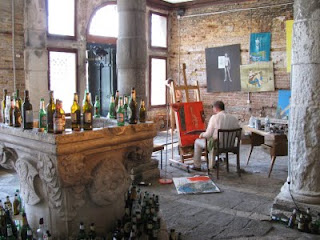So, we always go to the Venice Biennale, but we try never to go to the opening. One year we were there during the opening by mistake and we never got to eat at our favorite restaurants or see any of our favorite sites because we kept running into people we knew. At the same time, not being in the “in” group, we didn’t go to any of the events, so I felt both deprived of my favorite places and left out at the same time. Plus, it was the hottest June anyone could remember. So I always try to go at least a week after it opens, especially since the prices go down in Venice after July 1.
If you don’t go to the opening, you see the exhibition that everyone else sees. For example, the entire Dutch Pavilion was closed because there were malfunctions for the Fiona Tan videos. Half the Greek Pavilion was closed, again for technical reasons, so we only saw Lucas Samaras’s wall pieces. It was peaceful, there was space in the cafes and restaurants, we didn’t have to line up for anything. Interestingly, the two places I'm mentioning here were not in the official Biennale sites, but were national pavilions in offsite locations, part of the fascination with the Biennale, where finding national exhibitions involves discovering some of the nooks and crannies of historical Venice.
At the Icelandic Pavilion, one of my favorites because it’s on the ground floor of a building with a dock on the Grand Canal, we could see the progress Ragnar Kjartansson was making in his daily paintings. His exhibition is to paint each day a picture of a the same model, who I think is also a friend of his.
 By the time we got there, he had finished about 30 paintings.
By the time we got there, he had finished about 30 paintings.I didn’t think he was making much progress in improving his painting style or technique, but it was very pleasant to walk into a working studio, with Frank Sinatra’s Only the Lonely playing on the record player and dozens of empty beer bottles and cigarette butts littering various surfaces. Nothing fancy and no hype, just an artist and his model, working and not talking much to each other or anybody.  Plus you could go out on the dock and enjoy the Grand Canal.
Plus you could go out on the dock and enjoy the Grand Canal. 
 Plus you could go out on the dock and enjoy the Grand Canal.
Plus you could go out on the dock and enjoy the Grand Canal. 
At the opening you would have learned what the project was, but there would have been only a couple of paintings. By the time we were there, the model was growing a beard and we could see that Kjartansson was painting him in a variety of poses. I’d love to see it now, after they’ve been together for more than three months, still at it.
When people ask us how the 2009 Biennale was, Tom says it was boring. I can’t give it that quick an adjective, but a lot was totally puzzling to me and I don’t think anything intrigued and engaged me the way Sophie Calle did in the 2007 French pavilion. But I can’t get the Mexican pavilion out of my mind: “What else could we talk about?” The artist is Teresa Margolles. We had a hell of a time finding the palace where it was and I was about to give up, except that we had been so impressed in 2007 with their display in another palace.
Finally we found it.
We went to the piano nobile of the palazzo Rota-Ivancich. There was almost nothing there. But she displayed large cloths that the label said were soaked in the blood of people killed in the Mexico drug wars.
A young man was washing the floors, something he does at least once a day, with water mixed with the blood of the dead.

A wall made from mud mixed with the blood of the dead greeted us as we were leaving.
And at the entrance we saw an image of the United States Pavilion hung with the blood soaked cloths of her exhibition. There was a German couple there, asking the attendants why she should have wanted the United States Pavilion to have such an upsetting display. The attendant, who was Italian, seemed confused, so I said “Because they get the guns from us and we buy the drugs.” And we left.
And at the entrance we saw an image of the United States Pavilion hung with the blood soaked cloths of her exhibition. There was a German couple there, asking the attendants why she should have wanted the United States Pavilion to have such an upsetting display. The attendant, who was Italian, seemed confused, so I said “Because they get the guns from us and we buy the drugs.” And we left.




No comments:
Post a Comment